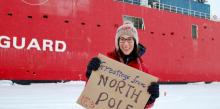Simone B. Moos, a postdoctoral associate in the Boyle Group, developed one of the first reliable methods to measure chromium isotope ratios in seawater, which she now employs to study the relatively unexplored marine cycling of that metal.
Simone originally joined the Boyle Lab in 2011 as a graduate student in the MIT-WHOI Joint Program in Chemical Oceanography. After successfully defending her thesis “The Marine Biogeochemistry of Chromium Isotopes” in September 2017, she remains in the group as a postdoc. She developed one of the first methods to measure chromium (Cr) isotope ratios in seawater. A critical step to doing this is reliably preconcentrating and purifying nano-molar chromium from the seawater matrix, which is challenging and has only been achieved by two other research groups in the world.
Chromium isotope signatures in the geologic record have been used to assess past atmospheric oxygen conditions, but with very little data reported from the modern marine and terrestrial environment, the interpretation of these isotope ratios is difficult. During her PhD, Moos analyzed water column profiles from the Arctic, Central North Pacific, Eastern Tropical North Pacific oxygen-deficient zone, and the partially anoxic Santa Barbara Basin. Her data show for the first time that the reduction of Cr(VI) to Cr(III) in oxygen-depleted seawater is accompanied by significant isotope fractionation. The lighter isotopes preferentially transform to Cr(III), which is scavenged from the water column due to its particle reactivity, resulting in heavier residual chromium.
 Simone off of Greenland at 75 degrees north with R/V Polarstern in 2010
Simone off of Greenland at 75 degrees north with R/V Polarstern in 2010
In 2015, Moos traveled from Alaska to the North Pole aboard the icebreaker USCGC Healy. This expedition was part of the international research program GEOTRACES, which studies the biogeochemical cycling of trace elements and their isotopes in the ocean. During the 10-week Arctic mission, Moos collected seawater samples for her own innovative work, the Boyle lab’s long-standing lead isotope research, and the wider US trace metal community. As many questions regarding the marine chromium cycle remain unanswered, Moos will continue analyzing chromium isotope signatures of seawater samples during her postdoc.
Story Image: Simone at the north pole during the Arctic GEOTRACES GN01 expedition in 2015 with USCGC Healy
Link to article:



